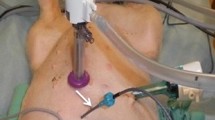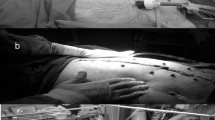Abstract
Background
Hyperthermic intraperitoneal chemotherapy (HIPEC) is being evaluated for patients with minimal residual or no residual disease after primary surgery and chemotherapy for stage III ovarian carcinoma. The technical feasibility of the laparoscopic approach for HIPEC has been demonstrated in a previous study. An experimental study on the porcine model was carried out to compare oxaliplatin pharmacokinetics during a laparoscopic-assisted procedure versus the coliseum technique for HIPEC.
Methods
Adult pigs received an HIPEC procedure that was based on 460 mg/m2 of oxaliplatin over 30 minutes with a perfusate heated at 41°C to 43°C. The HIPEC drains were placed in the upper and lower quadrants of the abdomen. Peritoneal fluid and blood samples were collected every 10 minutes during the procedure, and the pharmacokinetics of oxaliplatin was studied.
Results
Two groups of 10 adult pigs were studied. All the procedures were successfully completed with an adequate intra-abdominal temperature and distribution. No major technical problems were encountered. At the end of the HIPEC, 41.5% of the molecule was absorbed in the laparoscopic group compared with 33.4% in the laparotomy group (P = .0543). Peritoneal oxaliplatin half-life (T½) was significantly faster in the laparoscopic procedure (median, 37.5 vs. 59.3 minutes, P = .02). The area under the curve ratio of peritoneal to plasma reflects a more important oxaliplatin crossing through the peritoneal barrier in the laparoscopic procedure (ratio, 16.4 in the closed procedure vs. 28.1 in the open one; P = .03).
Conclusions
This study confirms the technical feasibility and reliability of the laparoscopic approach for HIPEC, and it extends knowledge concerning peritoneal drug absorption. Oxaliplatin absorption is far higher with laparoscopy in terms of time course in peritoneal perfusion. Clinical application in selected patients may be expected after further experimental investigation designed to define the adequate drug dosage.





Similar content being viewed by others
References
Bristow RE, Tomacruz RS, Armstrong DK, Trimble EL, Montz FJ. Survival effect of maximal cytoreductive surgery for advanced ovarian carcinoma during the platinum area: a meta-analysis. J Clin Oncol 2002;20:1248–59
Verwall VJ, van Ruth S, de Bree E, et al. Randomised trial of cytoreduction and hyperthermic intraperitoneal chemotherapy versus systemic chemotherapy and palliative surgery in patients with peritoneal carcinomatosis of colorectal cancer. J Clin Oncol 2003;21:3737–43
Sugarbaker PH. New standard of care for appendiceal epithelial neoplasms and pseudomyxoma peritonei syndrome? Lancet Oncol 2006;1:69–76
Ferron G, Gesson Paute A, Classe JM, Querleu D. Feasibility of laparoscopic peritonectomy followed by intra-peritoneal chemohyperthermia: an experimental study. Gynecol Oncol 2005;99:358–61
Armstrong DK, Bundy BN, Wenzel L, et al. Intraperitoneal cisplatin and paclitaxel in ovarian cancer. N Engl J Med 2006;354:34–43
Leblanc E, Querleu D, Narducci F, Occelli B, Papageorgiou T, Sonoda Y. Laparoscopic restaging of early stage invasive adnexal tumors : a 10-year experience. Gynecol Oncol 2004;94:624–9
Paraskeva PA, Purkayastha S, Darzi A. Laparoscopy for malignancy: current status. Semin Laparosc Surg 2004;11:27–36
Elias D, Bonnay M, Puizillou M, et al. Heated intra-operative intraperitoneal oxaliplatin after complete resection of peritoneal carcinomatosis: pharmacokinetics and tissue distribution. Ann Oncol 2002;13:267–72
Elias D, Antoun S, Raynard B, et al. Treatment of treatment of peritoneal carcinomatosis using complete excision and intraperitoneal chemohyperthermia. A phase I–II study defining the best technical procedures. Chirurgie 1999;124:380–9
Sugarbaker PH, Landy D, Pascal R, Jaffe G. Histologic changes induced by intraperitoneal chemotherapy in patients with peritoneal carcinomatosis from cystadenocarcinoma of the large bowel. Cancer 1990;11:1–14
el-Yazigi A, Al-Saleh I (1986) Rapid determination of platinum by flameless atomic absorption spectrophotometry following the administration of cisplatin to cancer patients. Ther Drug Monit 8:318–20
Elias D, Blot F, Otmany A, et al. Curative treatment of peritoneal carcinomatosis arising from colorectal cancer by complete resection and intraperitoneal chemotherapy. Cancer 2001;92:71–6
Garofalo A, Valle M, Garcia J, Sugarbaker PH. Laparoscopic intraperitoneal hyperthermic chemotherapy for palliation of debilitating malignant ascites. Eur J Surg Oncol 2006
Sugarbaker PH. An instrument to provide containment of intraoperative intraperitoneal chemotherapy with optimized distribution. J Surg Oncol 2005;92:142–6
Stuart OA, Stephens AD, Welch L, Sugarbaker PH. Safety monitoring of the coliseum technique for heated intraoperative intraperitoneal chemotherapy with mitomycin C. Ann Surg Oncol 2002;9:186–91
Jacquet P, Stuart A, Chang D, Sugarbaker PH. Effects of intra abdominal pressure on pharmacokinetics and tissue distribution of doxorubicin after intra peritoneal administration. Anti Cancer Drugs 1996;7:596–603
Esquis P, Consolo D, Magnin G, et al. High intra-abdominal pressure enhances the penetration and antitumor effect of intraperitoneal cisplatin on experimental peritoneal carcinomatosis. Ann Surg 2006;244:106–12
Acknowledgments
Supported by the research program of the Institut Claudius Regaud Cancer Center; by Sanofi-Aventis, which provided the drug; and Karl Storz Inc., which provided the laparoscopic equipment. All the experiments were carried out in the surgery laboratory of Rangueil University Hospital, Toulouse, France.
Author information
Authors and Affiliations
Corresponding author
Rights and permissions
About this article
Cite this article
Gesson-Paute, A., Ferron, G., Thomas, F. et al. Pharmacokinetics of Oxaliplatin During Open Versus Laparoscopically Assisted Heated Intraoperative Intraperitoneal Chemotherapy (HIPEC): An Experimental Study. Ann Surg Oncol 15, 339–344 (2008). https://doi.org/10.1245/s10434-007-9571-9
Received:
Revised:
Accepted:
Published:
Issue Date:
DOI: https://doi.org/10.1245/s10434-007-9571-9




